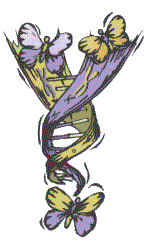Making Sense of Genetics
In spite of the fact that virtually all of us have had a high school
course in biology and passed a unit exam on genetics, the emphasis on genetics
and the evidence based on genetic evidence leaves many of us confused about
what is being said and what is not being said. With genome projects now
filling the literature and with more and more evolutionary arguments being
made from genetic data, this trend is not going to reverse. What we hope
to do in this article is to clarify what the words mean and explain in
simple terms what the implications of genetic facts are for the issues
of our day.
The word genome is a word for the biological instruction for how
an individual is to be formed and how the cells in the body function. The
genome is contained in a material called deoxyribonucleic acid (DNA). This
is a coil about five feet long, but less than the width of a human hair
(20 microns--a human hair is 50 microns wide.) The DNA is actually coiled
 into a structure called a double helix. The helix has some three billion
sub units called base pairs which make up the double helix. The information
centers between the base pairs are called genes. These genes give coded
instructions to the cell on how to assemble proteins for whatever the cell
is supposed to do. Proteins are a complex combination of amino acids--materials
that contain carbon, hydrogen, nitrogen, oxygen, and sometimes sulfur which
make up all plant and animal material. Genes direct proteins that the cell
uses to function, to repair itself, to defend itself, or to reproduce.
The making of the protein from this code is called "gene expression." The
base pairs between the genes are referred to as "junk DNA" and for the
most part have no known function. An oversimplified analogy would be to
visualize DNA as a book, genes as the pages within the book, proteins as
the words on the pages, amino acids as the letters that make up the words,
and ink as the atoms that make up the amino acids.
into a structure called a double helix. The helix has some three billion
sub units called base pairs which make up the double helix. The information
centers between the base pairs are called genes. These genes give coded
instructions to the cell on how to assemble proteins for whatever the cell
is supposed to do. Proteins are a complex combination of amino acids--materials
that contain carbon, hydrogen, nitrogen, oxygen, and sometimes sulfur which
make up all plant and animal material. Genes direct proteins that the cell
uses to function, to repair itself, to defend itself, or to reproduce.
The making of the protein from this code is called "gene expression." The
base pairs between the genes are referred to as "junk DNA" and for the
most part have no known function. An oversimplified analogy would be to
visualize DNA as a book, genes as the pages within the book, proteins as
the words on the pages, amino acids as the letters that make up the words,
and ink as the atoms that make up the amino acids.
If a gene is damaged by something like radiation, a chemical, or some
environmental factor, then whatever function the cell was supposed to do
with the protein from that gene will not be done properly. Genetic diseases
are caused when something like this happens to a vital cell. Some things
might not be that critical to the survival of the individual. One of the
reasons to do genetic research is to learn what genes do what. If a disease
is caused by such a change, it might be possible to correct it. There is
compelling evidence that many serious human ailments may be able to be
helped by such methods. Genes are contained in packages called chromosomes.
Science has numbered 22 chromosomes plus two that determine gender. A female
has two chromosomes called X. A male has one X and one called Y. You have
probably heard that the male controls the sex of his child, and that is
true. If his X chromosome is used, the resulting child will be XX and the
child will be a girl. If his Y chromosome is used, the resulting child
will be XY and will thus be a boy. Notice that at least in theory this
gives a 50/50 probability that a child will be a boy or a girl leaving
the world with potentially equal numbers of men and women.

We get half of our genes from each of our parents. This is an important
design feature in our makeup. (Notice the example of the butterfly producing
one butterfly with the yellow color and one with the gray color when the
parent butterfly has part yellow and part gray coloring.) A human being
contains 30,000 genes as compared with a bacterium which might have about
2000. There are many opportunities for errors in the reproduction of human
genes. If you were to copy the whole Bible, it would be very hard not to
believe you would make some mistakes. These mistakes are called mutations,
and they happen with regularity due to the fact that we do not live in
a perfect world. There are chemicals, radiation, and a variety of other
things which can mess up the reproduction of genes. These mutations have
a 50/50 chance of working their way into our offspring. Mutations usually
show up in eight reproductive cells at a time. Since the odds of the mutation
is 50/50, four of the reproductive cells will have the change and four
will not. If the person was cloned from a parent that had a mutation, all
eight offspring would have the problem. This is why cloning is inferior
to normal sexual reproduction, and laboratory experiments are verifying
this problem. The point is that sexual reproduction reduces the effect
of mutations and there are other processes involving enzymes that can do
further repair work on our genes making mutations less of a problem than
they would be in any other reproductive scheme.


Since we get half of our genes from each of our parents, it is possible
to show relationships between individuals if we know what their genetic
makeup is. If our parent has a gene that has been damaged, the child has
a 50/50 chance (all things being equal) of also having that damage. If
the child has that mutation, there is no question of whether or not the
adult having that same mutation is the child's parent. This simplified
explanation is the basis of solving paternity suits. It is also how rape
questions can be settled, because no two men (outside of identical twins)
could have exactly the same mutation in their cells. Genetic counseling
is a thriving business today. The idea behind it is to tell prospective
parents what genetic risks they are taking if they have a child. We would
suggest this is a wise thing to do. It is a general biblical principal
that we are to weigh the cost of our actions and be sure that we are willing
to pay that cost. A much more dubious use of genetic counseling is to take
a genetic sample from an unborn baby to determine what medical problems
it will have in life, aborting the baby if the problems seem to be significant.
Insurance companies are interested in being able to predict what diseases
people will have before deciding whether to insure an individual against
health problems later in life.
Another use of the fact that we get 50% of our genes from each parent
is to establish history. Certain genes are so unique that they are able
to be traced from one generation to another. This is useful in legal situations,
but it is also useful in establishing relationships between groups. If
you had nine brothers and sisters and if there were an unusual trait in
your mother's genetic makeup, that trait would show up in many of her offspring.
Someone who had that trait would have a very strong case for claiming that
they were related to you. Newspapers have made much of the fact that we
share genetic characteristics with chimpanzees--98.5% of all genetic characteristics
between chimps and humans are the same. Does this mean that we are all
one and the same family?

|
Newspapers have made much of the fact
that we share genetic characteristics with chimpanzees--98.5% of all genetic
characteristics between chimps and humans are the same. Does this
mean that we are all one and the same family? |

|
The problem here is something called converging evolution. All one has
to do is to look at a chimpanzee and one can see that there are many characteristics
that they share with humans. What would you expect? We both have ten fingers
and ten toes. We both use flavor to tell whether we should eat something
or not, so our nose is above our mouth making flavor possible. Our body
torso is pretty much the same in shape and function, and our internal structures
are also the same--we have a stomach, a heart, two kidneys, a bladder,
etc. If one were to look at a porpoise and a shark, one might assume that
they are close relatives. As a child, I was pursued by a playful porpoise
one time and was scared out of my wits believing that I was being pursued
by vicious killer shark. What is needed to live successfully in the sea?
One must have a tail to push through the water. There needs to be a dorsal
fin to give stability and a sleek outward shape that cuts through the water
effectively. Converging evolution tells us that animals may look alike
when they share a common environment, because there is one perfect shape
to live in that environment. No one would claim that the shark and the
porpoise are related, even though they look very much alike. The genetic
makeup for their external body parts and forms would be very much alike.
The rest of their genetic makeup would be different because one is a mammal
and the other is a fish, but the idea that similarity is a proof of common
ancestry obviously does not stand up due to the effects of converging evolution.
Historical documentation would be needed to confirm that such a relationship
exists.

|
No one would claim that the shark and
the porpoise are related, even though they look very much alike. |

|
| Shark |
|
Porpoise |
We have attempted here to give a very basic and oversimplified picture
of what the vocabulary of genetics is for biological systems and what some
of the problems are in using genetics to prove historical relationships.
The question is not over whether change occurs or whether genetic relationships
can be made, but rather whether there are good reasons for those relationships
to exist other than common origins and chance operators shaping biological
systems to what we have today. Let us look at another oversimplification,
and that is what we would expect to happen if an intelligence created all
living things a relatively short time ago with absolutely no significant
change occurring. Before going any further let us emphasize that the Bible
does not give an age to the earth and we have consistently in this journal
not supported the view that the earth is about 6000 years old. Let us also
state that the Bible tells us that change in living things has taken place.
You cannot look at what Jacob did with Laban's flocks or at the change
in the serpent and not realize that change takes place. The point in this
over simplification is what would we expect an intelligent God to do genetically
if that God created all living things.
First of all, there would be a necessity for a common chemistry. It
would not be possible for animals to eat if the chemistry of their body
was radically different than the chemistry of what they were eating. You
cannot buy an arsenic burger at a fast food restaurant because its chemistry
would be destructive to your body. If you are going to have a common chemistry,
then the building blocks used by that chemistry will be the same for all
living things. A contractor will tend to build houses out of the same materials
and using a similar plan. Chemically it is essential that all life be pretty
much the same. Carbon has to be the base element and oxygen pretty much
has to be the oxidizing agent for the system to function. That means that
the genetic material used to build things will be pretty much alike. You
would not expect radically different designs if there were an intelligence
behind the creation. That would not be true of chance, but it would be
true of intelligence. All things that live in the sea and swim effectively
would have some commonality of plan. All things that fly would have similar
structures to produce wings and light weight materials to allow flight.
From a genetics standpoint, we would expect to see exactly what we see
if a designing God created each living thing to fit a niche in the ecological
system in which it was to survive.
Genetics is not an enemy of the Bible. Our new knowledge of genetics
raises moral and ethical issues for the scientific community. Albert Einstein
said one time that "religion without science is lame, but science without
religion is blind." There are many new issues to be answered that genetics
is bringing to our attention, and science can not answer these issues.
Religion offers help to the process of making good choices in morality
and ethics and must be involved. It is difficult to comprehend how anyone
can look at the beauty, complexity, wisdom, and design of the genetic system
and all that it allows us to do and to be and believe that this has come
about as a product of chance. There is incredible intelligence involved
in this system, and mankind has worked for well over 100 years just trying
to understand the basics of the system without mastering it. We now stand
on the threshold of being able to understand it well enough to make meaningful
changes for the betterment of all mankind. Let us hope that the uses of
this knowledge will be to better man, to boost his concept of his self
worth, and to improve life for all living things on this planet. That goes
with the command "subdue the earth, have dominion over the fish, over the
fowl, over the beast of the earth. (Gen 1:28)
--Reference: "Glossary of Genetic Terms" AP, and "Sex, Errors,
and the Genome," Natural History, June 6, 2001, pages 43-50.
Back to Contents
Does God Exist?, JulAug01.
 into a structure called a double helix. The helix has some three billion
sub units called base pairs which make up the double helix. The information
centers between the base pairs are called genes. These genes give coded
instructions to the cell on how to assemble proteins for whatever the cell
is supposed to do. Proteins are a complex combination of amino acids--materials
that contain carbon, hydrogen, nitrogen, oxygen, and sometimes sulfur which
make up all plant and animal material. Genes direct proteins that the cell
uses to function, to repair itself, to defend itself, or to reproduce.
The making of the protein from this code is called "gene expression." The
base pairs between the genes are referred to as "junk DNA" and for the
most part have no known function. An oversimplified analogy would be to
visualize DNA as a book, genes as the pages within the book, proteins as
the words on the pages, amino acids as the letters that make up the words,
and ink as the atoms that make up the amino acids.
into a structure called a double helix. The helix has some three billion
sub units called base pairs which make up the double helix. The information
centers between the base pairs are called genes. These genes give coded
instructions to the cell on how to assemble proteins for whatever the cell
is supposed to do. Proteins are a complex combination of amino acids--materials
that contain carbon, hydrogen, nitrogen, oxygen, and sometimes sulfur which
make up all plant and animal material. Genes direct proteins that the cell
uses to function, to repair itself, to defend itself, or to reproduce.
The making of the protein from this code is called "gene expression." The
base pairs between the genes are referred to as "junk DNA" and for the
most part have no known function. An oversimplified analogy would be to
visualize DNA as a book, genes as the pages within the book, proteins as
the words on the pages, amino acids as the letters that make up the words,
and ink as the atoms that make up the amino acids.






